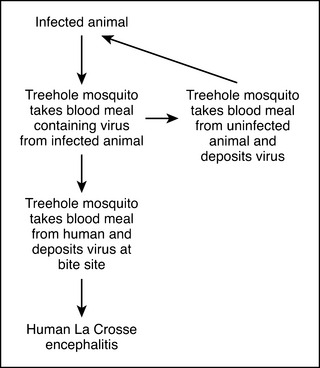LA CROSSE ENCEPHALITIS
La Crosse encephalitis is a mosquito-borne, viral disease with the potential of infecting the central nervous system in humans, usually children under 15. The disease is named for La Crosse, Wisconsin, where it was first identified in 1963.
TRANSMISSION
When a mosquito ingests blood from an infected mammal, the virus replicates in the mosquito and moves to other locations in the mosquito’s body, including the salivary glands. When the mosquito takes its next meal on an uninfected mammal, it deposits a small drop of saliva at the bite, which acts as an anticoagulant. The saliva contains the virus, which enters the mammal, replicates, and becomes a source of virus for other mosquitoes that come for a meal. Once infected, the mosquito is infected for life (Figure 22).
Stay updated, free articles. Join our Telegram channel

Full access? Get Clinical Tree



